Get Complete Project Material File(s) Now! »
Rating of sign illustrations
With regard to selecting signs in terms of the graphic representations, it was crucial to the study that their contribution to the sign-learning process be considered with regard to the development of equitable sign sets. There is a lack of guidance in the literature with regard to characteristics of sign illustrations influencing learning. However, sign illustrations have been selected in terms of clarity, point of contact, and location (Loeding et al., 1990) and these were considered together with a rating. Twenty of the students who participated in the rating of performance difficulty participated in the ratings of the sign illustrations in terms of the ease of sign production following observation of the sign illustration, using a 7 point rating scale. Mean scores were calculated and used to classify the sign illustrations. The results (Appendix 11) indicated that about half (51%) were considered easy (scores from 5 – 7), 33% were considered average (scores from 4 – 4.9) and 16% were difficult (scores from 1- 3.9). It was decided that signs with scores below 5 be kept to a minimum and be allocated equally across sets.
In summary, the selection of signs was determined primarily through rating scores obtained for translucency. Performance difficulty and sign illustration scores (graphic scores) were used as supplementary procedures. (Appendix 11 presents the composite list of 122 signs across the semantic categories, together with rating scores obtained for the various aspects). Signs were matched on these aspects with the goal of developing equivalent sets of signs through which the sign teaching strategies could be evaluated. This pool of 122 signs was then used to determine the sign sets.
Testing for sign equivalence
Twenty-one sets of four signs were selected, 16 of which were considered equal in terms of the above codes, and five unequal in that they were not selected from within the same code category. Ten student volunteers, who considered themselves somewhat proficient in signing, having completed a basic SASL course the previous year, were invited to participate in the rating of the signs for equivalence by observing a video of the sign groupings. A seven-point rating scale was used to describe each of the sign groups in terms of their similarity in level of difficulty during the learning process. A score of 1 meant that the set was very dissimilar, 2 = dissimilar, 3 = somewhat dissimilar, 4 = average, 5 = somewhat similar, 6 = similar and 7 meant the set was very similar. Participants were also asked to note a particular sign/s that may not fit, i.e. were “off”. Mean scores were calculated and compared. Refer to Table 3.3 for the results.
Allocation of signs to sets
The four sets of 15 signs available were distributed equally but within the constraints of the selected themes. However, the 15 probe signs in each set were supplemented by nine more signs to create sign sets which totalled 24, for a theme-based graphic display size compatible for graphic symbol use (Goossens’ et al., 1995). These signs, and associated sign illustrations, were not formally selected for the purpose of equivalence but rather for congruence with the themes and for a spread of grammatical categories from the pool of 122 signs based on parent-submissions and researcher-input described previously in the development of themes to meet the criterion of semantic similarity (Loeding et al., 1990).
The linguistic considerations therefore resulted in an additional seven signs in the noun category and two in the descriptor category. To guide selection consistency, mainly high translucency signs, signs with easy and medium handshapes, and symmetrical over nonsymmetrical signs were selected where there was a choice. Signs were reallocated to themes in the event of two or more signs being similar, to meet the criterion of cheremic dissimilarity of signs in a set (Loeding et al., 1990). The signs comprising the final four sign sets, including the probes are shown in Table 3.8.
CHAPTER 1
PROBLEM STATEMENT AND RATIONALE
1.1 Introduction
1.2 Background
1.3 Terminology
1.4 Abbreviations
1.5 Chapter outlines
1.6 Summary
CHAPTER 2
THE TEACHING OF SIGNS
2.1 Introduction
2.2 Teaching of Sign Language to hearing individuals
2.3 The role of graphic representation in teaching signs
2.4 Sign characteristics influencing learning
2.5 Conclusion
2.6 Summary
CHAPTER 3
RESEARCH METHODOLOGY
3.1 Introduction
3.2 Aims
3.3 Research design
3.4 Participants
3.5 Phases of the study
3.6 Main study
3.7 Data analysis
3.8 Summary
CHAPTER 4
RESULTS AND DISCUSSION
4.1 Introduction
4.2 Reliability of data
4.3 Comparison of the effectiveness of the two sign teaching strategies
4.4 Relationship between sign acquisition and assistance with signs
4.5 Conclusion
4.6 Summary
CHAPTER 5
CONCLUSION, EVALUATIONS AND RECOMMENDATIONS
5.1 Introduction
5.2 Conclusion
5.3 Evaluation of the study
5.4 Recommendations for further research
5.5 Summary
REFERENCES




